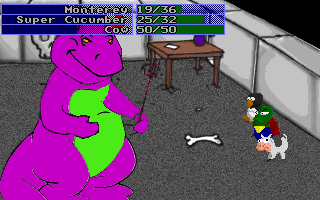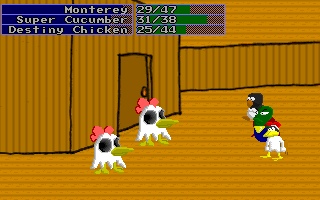A Retrospective by Paul Harrington
Download Here

Monterey Penguin
A Retrospective by Paul Harrington
Download Here

Monterey Penguin is considered one of the classics of old school OHR games, and it was certainly one of my favorites way back when it came out. The current version of the game was released in early 2000, and was one of the first games that really convinced me to make a serious attempt at designing my own game. As such, it holds a special place in my heart, but I had not replayed it since 2002 at the latest. Since this game was featured in last month's Top 5 OHRRPGCE Games You've Never Played article, I figured it was time to go back and see how well it aged.

I was immediately impressed by the fact that the intro is still better than what you'll find in most OHR games today. It's cute and well drawn, and the comic-strip style it uses suits the mood perfectly. The use of full screen artwork during cutscenes happens a few more times throughout the game, and really adds a lot of life to it. The game would be even stronger if every significant conversation used this style, but unfortunately several are just plain textbox scenes, often with as much text jammed into one box as possible.
The game's map graphics are very bland. There are some nice looking, cartoony character sprites, but the maptiles and map layouts are very average. The battle sprites and backdrops are all above average, and some are quite good, making the mediocre maps even more disappointing. It's not just a graphics issue, either; the maps are fairly large, but mostly empty. There's a lot of slow walking through areas that have very little physical variety to them. Because of this, walking back to town to heal/buy items becomes a chore. Thankfully, the random encounter rate is low, so you're not getting mercilessly clobbered as you trek back and forth for supplies in the early part of the game.

MP's gameplay is its biggest weakness. My main issue with battles is the incredibly low reward from fighting. Most enemies, even difficult ones, give you barely any gold or experience, and your stats don't grow very much when you level up. Gaining 2 gold from an enemy that can kill you in a couple of turns and then having to pay 10 to stay at an inn is a sign of terribly unbalanced game design. Also, equipment that you can buy in the game's first town doesn't make very much of a difference, which is annoying mainly because it's not cheap. Saving up gold to reduce damage taken from 4 to 3 feels like a waste of time.

There's an unfortunate and annoying bit of artificial difficulty added to the game to make things a bit more tedious; to save your game, you either have to visit the town weapon shop or use a consumable item that you have to purchase. It may just be that I don't have as much time to play games any more, but I greatly prefer being able to save often and anywhere, and have difficulty come from puzzles and tough battles rather than limiting how often I can take a break from playing.
Battle difficulty is another major problem. Aside from the final one, boss fights are well balanced (the boss of the underworld in particular is a really intense fight), but minor battles offer so little reward considering how much damage you'll take that they hardly seem worth fighting. There's also the odd fact that for some reason the Kitty enemies instantly killed SUPER CUCUMBER in one hit, even though bosses could not and these same enemies did relatively little damage to Monterey himself. Since you will take so much damage, you'll quickly become annoyed with how expensive healing is. It should also be noted that your healing spell cannot be used outside of battle.

The game starts to look stronger once you reach the second town; it has better music, better graphics, a less cliche appearance, and items you can buy there are actually worth buying. While I'm on the topic of music, the majority of the music in this game is extremely annoying. It uses ripped music that is decent in its original form, but some of these songs convert to midi/bam really terribly. The song used for the second town is Rawhide, which is pretty great in any form, and converts fairly well. This is also the most well placed song in the game.

While the audio/visual aspects of the game get stronger here, the gameplay unfortunately does not. You'll be attacked by enemies who can kill you easily in two hits and yield barely any reward. You'll fight living Peeps, which should be awesome but is instead just incredibly annoying since each one you defeat splits into four smaller monsters. This doesn't make the battle more difficult, since they can do practically no damage to you. Instead it simply makes the battles way, way too long. And again, the amount of money/experience you get is negligable. To make things even more annoying, there's no inn in this town. The only ways to heal are to buy overpriced items or to use a water trough in the northern part of town. Of course, getting to the trough is ridiculously annoying, since you have to fight your way through swarms of Peeps that don't leave the map after you defeat them. If you actually need to heal, you won't survive long enough to make it to the trough and will save yourself an hour of wasted time if you just return to the previous town and use the inn there.

It should be noted that the majority of the game consists of fetch quests, and nearly all of them are extremely tedious. The first one in the game is a simple task made annoying by bad game design choices. A redneck is blocking your path; he will move if you retrieve some moonshine. Sounds simple, and should be, considering you only have access to a small area to explore. You find it by using a secret passage in a house that only appears if A) You've already talked to the redneck and B) You talked to the cow after talking to the redneck. Now, this secret passage isn't very well hidden, and I tried accessing it before realizing I was even supposed to, and the game did not allow me to enter. There's absolutely no reason to block the player from entering this passage and retrieving the item before talking to these characters, and doing so forces the player to walk back and forth through plain looking areas while shrill music plays for far too long.
A similar and far more infuriating occurance of this is found in the desert. If you try to explore the desert, you may come across a set of tools. Getting to these tools is a pretty rough ordeal, as you'll have to fight/run from a lot of battles along the way. Unfortunately, if you haven't talked to Phil, a character located substantially far away from these tools, you are not allowed to pick them up, even though it's damn clear that they're going to be useful.

The game ends after completing a series of fetch quests in the desert area, and it's made painfully clear just how incomplete the whole game is. You only get to complete a third of the mission that Monterey is given, and the final encounter of the demo is very half-assed and rushed.
I should hope by this point my opinion of this game is clear, and it makes me a bit sad, because seven years ago I really enjoyed it. To be honest, I'm not sure how I could have. It has aged horribly, and it actually amazes me to compare this, one of the most popular OHR games of its time, to the most popular ones today. Monterey Penguin is still charming and still has a great sense of style, but its gameplay ranges from tedious to abysmal. It's a cute and funny game, but this isn't enough to make up for its shortcomings. I really wish the game had been completed, because most of its problems could have been easily fixed with playtesting. This is a perfect example of a game with great potential that falls flat because of terribly balanced stats and a lack of testing. I can't recommend it to anyone but people curious about what was popular when the OHR was (relatively) young.
